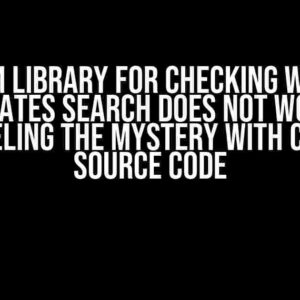Are you tired of banging your head against the wall, trying to figure out why your GraphQL query with variables is resulting in a frustrating 400 error? Worry not, dear developer, for you’re not alone! In this article, we’ll embark on a thrilling adventure to diagnose and solve this pesky issue, making your GraphQL journey a whole lot smoother.
The 400 Error Enigma: What’s Going On?
When you send a GraphQL query with variables, you expect a beautiful response with your desired data. But, alas, the 400 error intervenes, leaving you perplexed and frustrated. So, what’s causing this mysterious error?
The 400 error is a generic HTTP status code indicating a bad request. In GraphQL, it usually means that the server couldn’t understand or process your query. But, don’t worry; we’ll get to the bottom of this!
Common Causes of the 400 Error
- Invalid Query Syntax: A single mistake in your query syntax can lead to a 400 error. Double-check your query for typos, incorrect field names, or invalid syntax.
- Missing or Incorrect Variables: Make sure you’re passing the correct variables with the correct types. GraphQL is strict, and a single mismatch can cause the error.
- Server-Side Issues: Sometimes, the issue lies on the server-side. Check your server logs for any errors, and ensure that your server is properly configured to handle GraphQL queries.
- Insufficient Permissions: If you’re using authentication or authorization, ensure that you have the necessary permissions to access the requested data.
- Network Connectivity Issues: A slow or unstable network connection can cause the 400 error. Try checking your network connection and retrying the query.
Debugging and Troubleshooting Strategies
Now that we’ve covered the common causes, let’s dive into some debugging and troubleshooting strategies to help you identify the root cause of the issue.
Check the Error Message
When you receive a 400 error, GraphQL usually returns an error message that can provide valuable insights into the problem. Take a closer look at the error message to identify the specific issue.
{
"errors": [
{
"message": "Variable '$id' is not defined",
"locations": [
{
"line": 2,
"column": 3
}
]
}
]
}
In this example, the error message clearly indicates that the variable ‘$id’ is not defined. Ah-ha! Now we know where to look.
Use the GraphQL Playground or a Similar Tool
The GraphQL Playground is an excellent tool for testing and debugging GraphQL queries. It allows you to send queries, inspect the response, and even introspect the GraphQL schema.
By using the GraphQL Playground, you can:
- Test your query with variables and see the response
- Explore the GraphQL schema and ensure that your query is correct
- Identify any issues with your variables or query syntax
Check Your Server-Side Logs
Sometimes, the issue lies on the server-side. Check your server logs to see if there are any errors or warnings related to your GraphQL query.
Look for errors like:
Error: Cannot query field 'nonExistentField' on type 'Query'. ```This error indicates that there's an issue with the field 'nonExistentField' on the Query type.
Solving the 400 Error: A Step-by-Step Guide
Now that we've discussed debugging and troubleshooting strategies, let's walk through a step-by-step guide to solving the 400 error.
Step 1: Review Your Query Syntax
Double-check your query syntax for any typos, incorrect field names, or invalid syntax.
query GetUser($id: ID!) { user(id: $id) { name email } }Ensure that your query is correctly formatted and that you're using the correct field names.
Step 2: Verify Your Variables
Check that you're passing the correct variables with the correct types.
variables: { "id": "1" }Make sure that the variable 'id' is defined and has the correct type (in this case, ID!).
Step 3: Check Server-Side Logs
Review your server-side logs to identify any errors or warnings related to your GraphQL query.
Step 4: Inspect the Response
Inspect the response from the server to identify any errors or warnings.
{ "errors": [ { "message": "Variable '$id' is not defined", "locations": [ { "line": 2, "column": 3 } ] } ] }Take note of the error message and identify the specific issue.
Step 5: Test and Refine Your Query
Test your query with the corrected variables and syntax.
query GetUser($id: ID!) { user(id: $id) { name email } } variables: { "id": "1" }Refine your query until you receive the desired response.
Conclusion
Solving the 400 error when using GraphQL queries with variables requires a systematic approach to debugging and troubleshooting. By following the steps outlined in this article, you'll be well-equipped to identify and fix the issue, ensuring that your GraphQL journey is smoother and more productive.
Remember, the 400 error is not a mystery; it's an opportunity to learn and improve your GraphQL skills. So, go ahead, take a deep breath, and dive back into your GraphQL adventure!
| Common Causes of the 400 Error | Troubleshooting Strategies |
|---|---|
| Invalid Query Syntax | Check query syntax, use GraphQL Playground |
| Missing or Incorrect Variables | Verify variables, check server-side logs |
| Server-Side Issues | Check server-side logs, inspect response |
| Insufficient Permissions | Check authentication and authorization |
| Network Connectivity Issues | Check network connection, retry query |
By using the strategies outlined in this article, you'll be able to tackle the 400 error with confidence and ease. Happy GraphQL-ing!
Here are 5 Questions and Answers about "GraphQL query with variables results in 400 error":
Frequently Asked Question
GraphQL variables got you down? Don't worry, we've got the answers to get you back up and running!
Why do I get a 400 error when using GraphQL query variables?
This error often occurs when the variable values don't match the expected type or format. Double-check your variable definitions and ensure they align with the GraphQL schema. Also, make sure to pass the variables in the correct format, such as JSON objects for complex types.
How do I debug GraphQL query variables that are causing a 400 error?
Debugging is key! Try using GraphQL Playground or a similar tool to test your query with variables. This will help you identify the specific issue. You can also enable debug logging on your GraphQL server to get more detailed error messages.
Can I use GraphQL query variables with default values to avoid 400 errors?
Yes, you can! Defining default values for your variables can prevent 400 errors caused by missing or invalid values. This way, your query will fall back to the default value if the variable is not provided or is invalid.
Do I need to escape special characters when using GraphQL query variables?
Good thinking! Yes, you should escape special characters in your variable values to avoid syntax errors. For example, if your variable value contains quotes, escape them with a backslash (\). This will ensure your query is correctly interpreted.
How do I handle null or undefined values in GraphQL query variables?
Handle with care! Null or undefined values can cause 400 errors. To avoid this, use GraphQL's built-in nullability feature or wrap your variable values in a nullable type, such as `String` instead of `!String`. This will allow your query to handle null or undefined values gracefully.





